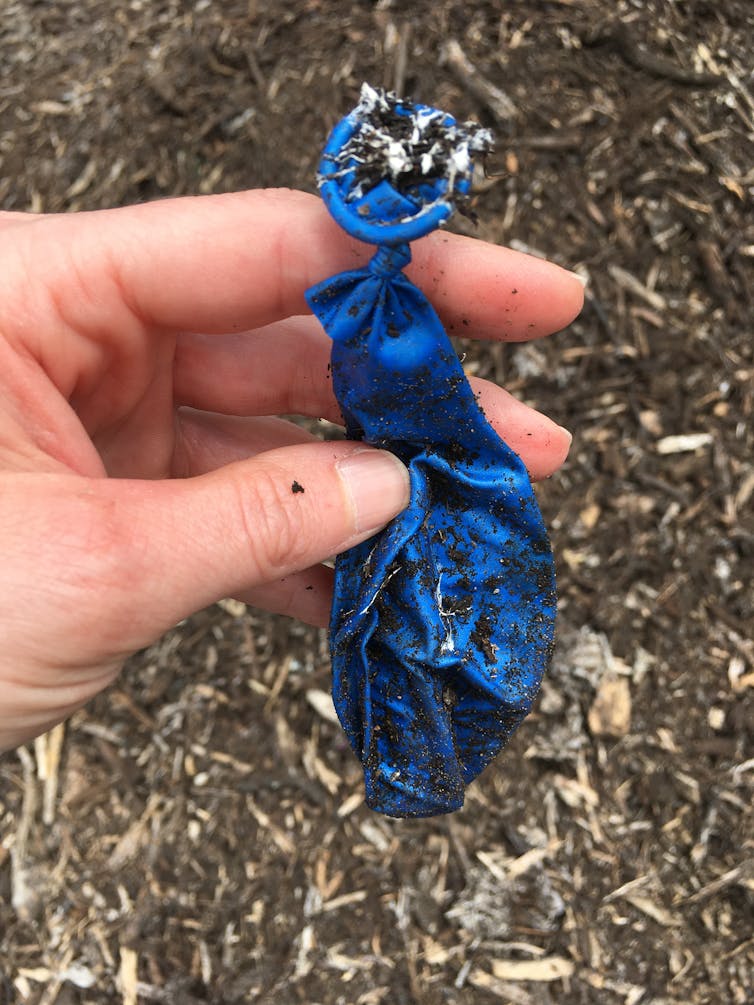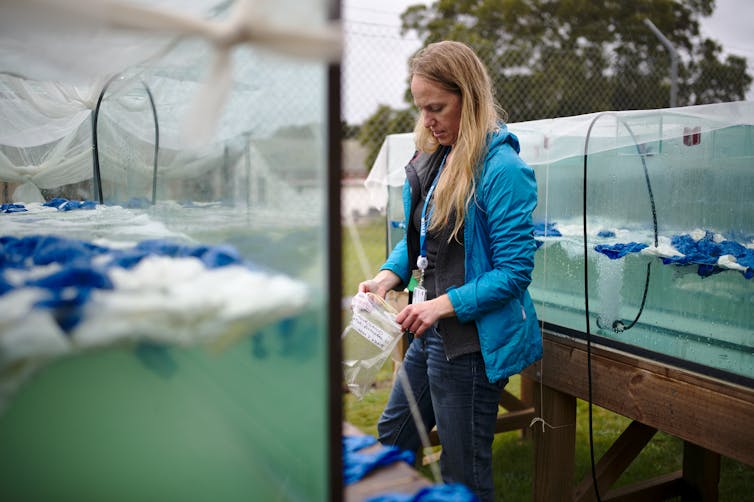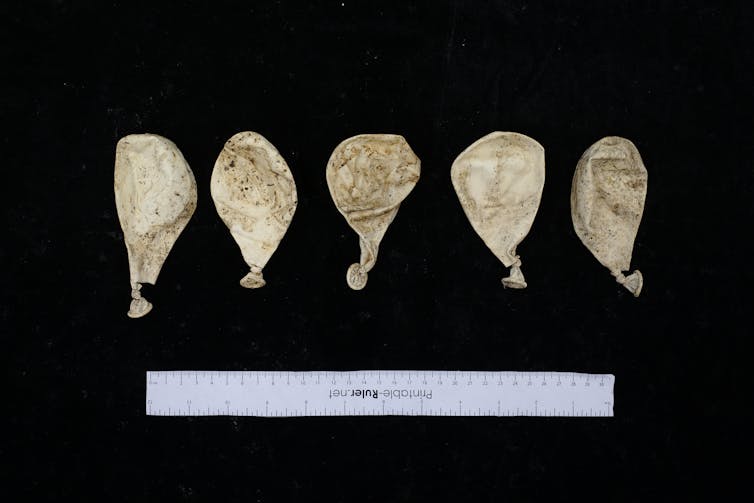Dear Google..do You Not Know What Latex Free Balloons Means???
Afterwards sixteen weeks in an industrial compost heap, we unearthed blue and white balloons and found them totally unscathed. The knots we spent hours painstakingly tying by manus more than four months ago were still attached, and sparkly blue balloons still glinted in the sun.
These balloons originally came from packages that advertised them as "100% biodegradable", with the manufacturers assuring they were made of "100% natural latex prophylactic". The implication is that these balloons would have no trouble breaking down in the environment.
Baca juga: Balloon releases have deadly consequences – we're helping citizen scientists map them
This appeals to eco-conscious consumers, but really merely fuels corporate greenwashing — unsubstantiated claims of environmentally friendly and safety products.
Property perfectly intact balloons in our hands afterward iv months in industrial compost, we had cause to question these claims, and ran experiments.
What's the problem?
This problem is ii-fold. Outset, balloons are additional plastic waste material in the environment. They are lightweight and can travel on air currents far from the signal of release. For case, one 2005 study found a balloon travelled more than 200 kilometres.

When they pop, they float dorsum to the earth's surface and state in, for instance, the bounding main or the desert, and wash upward on beaches where animals tin can eat them, from bounding main turtles and seabirds to desert tortoises.
The stretchiness of balloons means they can become stuck in animals' digestive tracts, which will crusade choking, blockage, decreased food absorption and effectively starve the animal.
Baca juga: How to get abandoned, lost and discarded 'ghost' fishing gear out of the ocean
Second, what nearly consumers don't realise, is that to shape milky natural rubber latex sap into the production we know as a balloon, many boosted chemicals demand to be added to the latex.
These chemicals include antioxidants and anti-fogging (to annul that cloudy look balloons tin can get), plasticisers (to make it more flexible), preservatives (to enable the balloon to sit down in warehouses and store shelves for months), flame retardants, fragrance and, of course, dyes and pigments.
Even more chemicals have to be used to make the additives "stick" to the latex and to stick to each other, enabling them to work in tandem to create a product we await to use for about 24 hours. So, the balloons can't be "100% natural safety latex".

And yet, despite substantial evidence of harm and the presence of these chemicals, balloon littering persists. Balloon releases are common, with only some regional regulations in place, such as in New South Wales and the Sunshine Coast.
Lying for decades
While some factions of the airship industry denounce balloon releases, these claims are only recent.
For decades, the industry relied on one industry-funded report from 1989 which claimed that after vi short weeks, balloons degraded "at well-nigh the same rate as oak tree leaves" and there was no mode balloons were a threat to wild fauna.
That study was not peer-reviewed, its methods are unclear and not repeatable, and the results are based on merely half dozen balloons.
Baca juga: Avoiding single-utilize plastic was becoming normal, until coronavirus. Here's how we tin can return to skillful habits
Because balloons are often reported to be at bounding main, ingested by wild fauna and washed upward on beaches, it's clear they're not breaking downwards in merely six weeks. Anecdotal studies take tested this to varying degrees, confirming balloons don't suspension downwards.
Merely i peer-reviewed scientific study has quantified balloon deposition, and that also occurred in 1989 — the same year as the industry study. They tested elasticity for upwardly to ane year, which ways the balloons were intact for that whole time.

We wanted to know: has anything inverse since 1989? And why aren't in that location more studies testing airship deposition, given the passion backside the balloon issue?
Then, we set out to quantify exactly how long latex balloons would take to interruption down. And we asked if balloons degraded differently in different parts of the environment.
Our experiment tested their claims
Industrial composting standards require that the material completely disintegrates after 12 weeks and that the production is not distinguishable from the surrounding soil.
We designed an experiment: after exposing balloons to six hours of sunlight (to simulate typical apply, for example, at an outdoor party), we put bluish and white balloons in industrial compost, and in saltwater and freshwater tanks.
We allowed for aeration to simulate natural weather condition, but otherwise, we left the balloons solitary. Every two weeks, we randomly removed 40 balloons from each treatment. We photographed them to document degradation. So we tested them.

Were the balloons still stretchy? We tested this in the University of Tasmania engineering lab to determine tensile (resistence) strength. We found that in water tanks, the balloons became less stretchy, losing effectually 75% of their tensile strength. Just if they had been composted, balloons retained their stretchiness.
Were the balloons still composed of the same things they started with? We tested this by taking spectral measurements of the balloons' surface. The balloons showed signs they were exposed to ultra violet calorie-free in the water tanks, but not in the compost. This means their chemical composition changed in water, only only slightly.
Finally, and near importantly, did the balloons lose mass?
After xvi weeks, the balloons were still recognisably balloons, though they behaved a little differently in compost, water and saltwater. Some balloons lost 1–ii% mass, and some balloons in freshwater gained mass, likely due to osmotic assimilation of water.

What tin can we do?
Information technology's articulate latex balloons don't meaningfully degrade in 16 weeks and will continue to pose a threat to wildlife. So what can we do as consumers? We offer these tips:
- practise not release balloons outdoors
- do not use helium-filled balloons outdoors (this prevents adventitious release, and saves helium), which is a critically limited resource
- if y'all utilize balloons, deflate and bin them after utilise
- consider airship alternatives, similar bubbles
- make educated purchases with federal Green Guidelines in mind.
Baca juga: There are some single-use plastics we truly need. The rest nosotros can live without
Source: https://theconversation.com/we-composted-biodegradable-balloons-heres-what-we-found-after-16-weeks-138731
0 Response to "Dear Google..do You Not Know What Latex Free Balloons Means???"
Post a Comment